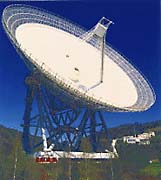Pulsars
Pulsars are very small, dense stars known as neutron stars, as small as only 20 km in diameter. We can detect regular periodic bursts of electromagnetic radiation that these stars emit as they spin. Some of them spin very fast - up to 1000 revolutions per second!
The very first pulsar was accidentally discovered in 1967 by Jocelyn Bell and Antony Hewish. Bell and Hewish were studying known radio sources with a large radio telescope at Cambridge University, when they detected periodic bursts of radio noise, apparently originating from one of these sources. At first the regularity of the pulses led scientists to speculate that they might be signals from extraterrestrial life, but as more similar sources were discovered, an explanation of their behavior became more clear.
The discovery of this pulsar and three others from Cambridge was soon followed by more discoveries at observatories around the world. All of the new objects behaved the same way, emitting short pulses of noise at a specific period that remained constant for each pulsar. The first pulsar, later named PSR 1919+21 because of its location on the sky, emitted a pulse every 1.33 seconds and the others had signature periods in the neighborhood of one to a few seconds. More recently, pulsars have been discovered which emit as many as 1000 pulses per second.
Since 1967 over one thousand pulsars have been discovered and catalogued, and it is now estimated that our own galaxy, the Milky Way, contains perhaps as many as one million pulsars. So why do we continue to look for new pulsars? What could possibly be so interesting about them that one thousand of them is not enough? Why do we even use radio telescopes to observe some the known pulsars as often as twice a month?

This content has been re-published with permission from SEED. Copyright © 2025 Schlumberger Excellence in Education Development (SEED), Inc.

